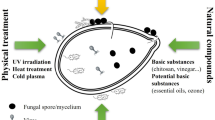Abstract
Sweet sorghum is an important fodder crop, besides which can be used for the multiple purposes like grain, jaggery making and ethanol production. Leaf blight caused by the Exserohilum turcicum is an important disease affecting the sorghum. Fourteen fungicides, five botanicals, seven bioagents and four ITKs evaluated against the leaf blight of sweet sorghum caused by E. turcicum. Among the non systemic fungicides, maximum percent mycelial inhibition was recorded in treatments involving the mancozeb and propineb at 0.25% (87.55%), among systemic fungicides tested, cent percent inhibition was noticed at all the three concentrations of propiconazole, hexaconazole and tebuconazole, among combiproduct fungicides, at all the three concentrations, highest inhibition of mycelial growth (100%) was noticed in carboxin 37.5% + thiram 37.5% and tebuconazole 50% + trifloxistrobin 25%, among commercially available botanicals highest inhibition of mycelial growth was noticed in multineemore (Azadiractin 0.15%) at 1% (68.75%). Consortium of three bioagents T. harzianum + P. fluorescens + B. subtilis at 3.3 g each/l has given the maximum inhibition (80.44%) spore germination among the bioagents. Among the ITKs panchagavya has given the maximum inhibition (30.60%) at 20% concentration. Among the nine spray schedule, spray schedule involving hexaconazole @ 0.1% − hexaconazole @ 0.1% − hexaconazole 0.1% recorded least percent disease index (28.00%) and least AUDPC (598.20) and highest fodder yield (40.36 t/ha), brix value (12.42%) and highest B:C ratio (1:1.46).
Similar content being viewed by others
References
Adaangadi KC, Harlapur SI, Savita C, Hadimani BR (2018) Studies on evaluation of fungicides against Curvularia lunata in maize. Int J Agric Sci 14(1):225–228
Ali S, Sharma BR, Yonzon R, Choudary AK (2015) Integrated management of turcicum leaf blight disease of maize (Zea mays L.) in hill agro-ecological zone of West Bengal. J Agric Technol 2(1):92–94
Bunker RN, Mathur K (2005) Biology and management of Exserohilumturcicum (Pass.) Leonard and Suggs.inciting sorghum [Sorghum bicolor (L.) Moench] leaf blight. Ph. D Thesis, Maharana Pratap Univ. Agric. Tech., Udaipur, Rajastana (India)
Butler EJ (1918) Fungi and diseases in plants. Calcutta and Simla, India. Thacker, Spink & Co., Kolkatta
Frederiksen RA (1982) Sorghum in the eighties: Proc. Int. Symp. Sorghum. 2–7 Nov. International Crop Research Institute forSemi-arid Tropics. Patancheru, Andhra Pradesh, India. pp 263–271
Harlapur SI, Kulkarni MS, Wali MC, Kulkarni S (2007) Evaluation of plant extracts, bio-agents and fungicides against Exserohilumturcicum (Pass.) Leonard and Suggs. causingturcicum leaf blight of maize. Karnataka J Agric Sci 20(3):541–544
Khedekar SA, Harlapur SI, Kulkarni S, Benagi VI (2012) Evaluation of fungicides, botanicals and bioagents against turcicum leaf blight of maize caused by Exserohilumturcicum (Pass.) Leonard and Suggs. Int J Pl Protect 5(1):58–62
Manu TG, Naik GB, Saipratap BR, Balagar MS (2017) Efficacy of fungicides, botanicals and bio-agents against Exserohilumturcicum. Chem Sci Rev Lett 6(24):2100–2107
Mayee CD, Datar VV (1986) Phytopathometry. Technical Bulletin-1 (special 3). Marathwada Agric Univ., Parbhani, p 218
Mitra M (1923) Helminthosporium species on cereals and sugarcane in India. Part I Diseases of Zea mays and Sorghum vulgare caused by species of Helminthosporium. Memoirs of the Dept. Agric. India. Bot Ser 11:219–242
Singh LS, Dutta R (2017) In vitro efficacy of native bio-control a control agents from gents from maize regime against Exserohilumturcicum in response to botanicals and fungicides. Bioscan 12(2):775–779
Sumangala K, Patil MB (2007) Panchagavya organic weapon against plan pathogens. J Mycol Pl Pathol 37(3):642
Vincent JM (1947) Distortion of fungal hyphae in the presence of certain inhibitor. Nature 159:800
Wani TA, Ahmad M, Anwar A (2017) Evaluation of fungicides, bioagents and plant extracts against Exserohilumturcicum causing turcicum leaf blight of maize. Int J Curr Microbiol Appl Sci 6(8):2754–2762
Wheeler BEJ (1969) An introduction to plant diseases. Wiley, London, p 301
Wilcoxson RD, Skovmand B, Atif AH (1975) Evaluation of wheat cultivars for ability to retard development of stem rust. Ann Appl Biol 80:275–281
Yadav B, Singh R, Kumar A (2015) Management of spot blotch of wheat using fungicides, bio-agents and botanicals. Afr J Agric Res 10(25):2494–2500
Author information
Authors and Affiliations
Corresponding author
Rights and permissions
About this article
Cite this article
Kiran, B.M., Patil, P.V. Integrated management of leaf blight of sweet sorghum caused by Exserohilum turcicum (Pass.) Leonard and Suggs. Indian Phytopathology 72, 63–69 (2019). https://doi.org/10.1007/s42360-018-0086-z
Received:
Revised:
Accepted:
Published:
Issue Date:
DOI: https://doi.org/10.1007/s42360-018-0086-z




